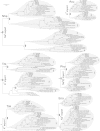Genome sequencing of four Aureobasidium pullulans varieties: biotechnological potential, stress tolerance, and description of new species
- PMID: 24984952
- PMCID: PMC4227064
- DOI: 10.1186/1471-2164-15-549
Genome sequencing of four Aureobasidium pullulans varieties: biotechnological potential, stress tolerance, and description of new species
Abstract
Background: Aureobasidium pullulans is a black-yeast-like fungus used for production of the polysaccharide pullulan and the antimycotic aureobasidin A, and as a biocontrol agent in agriculture. It can cause opportunistic human infections, and it inhabits various extreme environments. To promote the understanding of these traits, we performed de-novo genome sequencing of the four varieties of A. pullulans.
Results: The 25.43-29.62 Mb genomes of these four varieties of A. pullulans encode between 10266 and 11866 predicted proteins. Their genomes encode most of the enzyme families involved in degradation of plant material and many sugar transporters, and they have genes possibly associated with degradation of plastic and aromatic compounds. Proteins believed to be involved in the synthesis of pullulan and siderophores, but not of aureobasidin A, are predicted. Putative stress-tolerance genes include several aquaporins and aquaglyceroporins, large numbers of alkali-metal cation transporters, genes for the synthesis of compatible solutes and melanin, all of the components of the high-osmolarity glycerol pathway, and bacteriorhodopsin-like proteins. All of these genomes contain a homothallic mating-type locus.
Conclusions: The differences between these four varieties of A. pullulans are large enough to justify their redefinition as separate species: A. pullulans, A. melanogenum, A. subglaciale and A. namibiae. The redundancy observed in several gene families can be linked to the nutritional versatility of these species and their particular stress tolerance. The availability of the genome sequences of the four Aureobasidium species should improve their biotechnological exploitation and promote our understanding of their stress-tolerance mechanisms, diverse lifestyles, and pathogenic potential.
Figures






References
-
- Tada R, Tanioka A, Ishibashi K, Adachi Y, Tsubaki K, Ohno N. Involvement of branched units at position 6 in the reactivity of a unique variety of beta-D-glucan from Aureobasidium pullulans to antibodies in human sera. Biosci Biotechnol Biochem. 2009;73:908–911. doi: 10.1271/bbb.80860. - DOI - PubMed
Publication types
MeSH terms
Substances
LinkOut - more resources
Full Text Sources
Other Literature Sources
Miscellaneous

